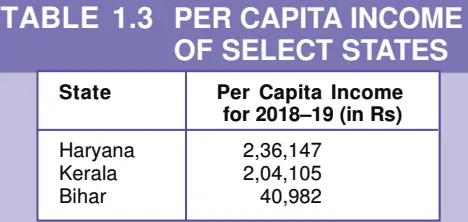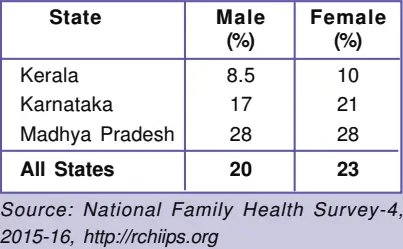NCERT Solutions of Economics for Class 10 Chapter 1 Development
INTEXT QUESTIONS
Let’s Work These Out
Question.1. Why do different persons have different notions of development? Which of the following explanations is more important and why?
(a) Because people are different.
(b) Because life situations of persons are different.
Answer. In the above two explanations, ‘B’ is more important, because the life conditions and the needs of people differ from each other according to the circumstances. On the basis of these needs, the goals or concepts of development of the people are also of different types.
Question.2. Do the following two statements mean the same? Justify your answer.
(a) People have different developmental goals.
(b) People have conflicting developmental goals.
Answer. Both the above statements have different meanings.
(a) The difference in the developmental goals of the people means that they choose such goods and services, which can give them more satisfaction.
(b) There is a conflict between the developmental goals of the people. Sometimes two persons or two groups may want such things, which may be in conflict, like a girl wants freedom opportunities like her brother and she also hopes that the brother also helps in household work, but this is not true. Probably her brother would not like it.
Question.3. Give some examples where factors other than income are important aspects of our lives.
Answer. Some other factors apart from income are also important aspects of our life. The people expect equal or non-discriminatory treatment. They want employment and in return better incomes. Similarly, they also want freedom of thought, freedom of religion and freedom of movement. People also want security of life, property and honour.
Question.4. Explain some of the important ideas of the above section in your own words.
Answer. People always want regular employment, better incomes, fair price for their crops or produce. Apart from better income, people have other developmental goals, such as equal treatment, freedom, safe shelter, proper education, health care and self-respect etc.
People see mixed goals for development. If women also do paid work, then they have many goals in the home as well as in the society. Due to a safe environment, more and more women can do different types of jobs or business and will also contribute to the development of family and country.
Let’s Work These Out
Discuss the following situations :
Question.1. Look at the picture below. 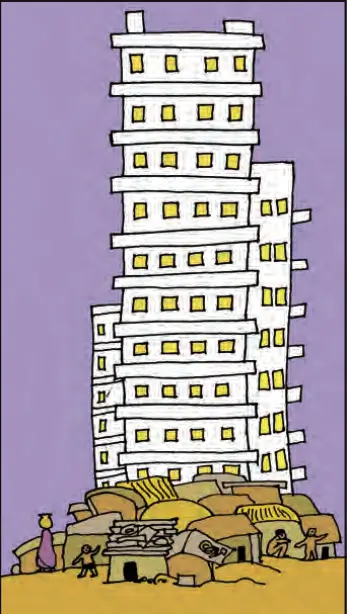
Answer. According to the picture, the developmental goals of this area should be as follows-
- Regional planning should be done properly. Adequate housing facilities should be made available to the people living in slums.
- Public facilities should be made available to all the people of the society, in which roads, schools, public toilets, ponds, community halls, hospitals, parks, reading rooms, etc. are important.
- The standard of living of the people living in slums should be improved by improving their economic condition.
- Water should be supplied regularly. This supply should be equally available to the rich people living in bungalows and the poor living in slums.
- All local settlements should be connected by means of public transport.
- There should be a police station near each settlement.
- There should be proper arrangement of electricity on the houses and roads of all the settlements.
- There should be a provision of lift in multi-storeyed buildings.
- There should be a fire brigade centre near the settlements.
- The supply of basic needs should be ensured in a planned manner.
Question.2. Read this newspaper report and answer the questions that follow:
A vessel dumped 500 tonnes of liquid toxic wastes into open-air dumps in a city and in the surrounding sea. This happened in a city called Abidjan in Ivory Coast, a country in Africa. The fumes from the highly toxic waste caused nausea, skin rashes, fainting, diarrhoea etc. After a month seven persons were dead, twenty in hospital and twenty six thousand treated for symptoms of poisoning. A multinational company dealing in petroleum and metals had contracted a local company of the Ivory Coast to dispose of the toxic waste from its ship.
(i) Who are the people who benefited and who did not?
Answer. Those who dumped the toxic waste have been benefited while the people of Abidjan in Ivory Coast were not benefited.
(ii) What should be the developmental goal for this country?
Answer. Pollution awareness should be the developmental goal for this country.
Question.3. What can be some of the developmental goals for your village, town or locality?
Answer. Sanitation, security, per capita income etc can be developmental goals for our locality.
Activity-1
Question.1. If even the idea of what constitutes development can be varied and conflicting, then certainly there can be differences about ways of developing. If you know of any such controversy, try to find out arguments advanced by different people. You may do so by talking to different persons or you may find it from newspapers and television.
Answer. There are differences and mutual contradictions in the views of people regarding development. Regarding the solution of various problems of the farmers, the approach of small farmers and big farmers is different. Their development also cannot be on one standard. For this, different types of standards will have to be made.
Let’s Work These Out
Question.1. Give three examples where an average is used for comparing situations.
Answer. Average is used to compare the following situations
- Average is used to compare the per capita income of any country.
- Average is used to compare the achievements of the students in any competitive examination.
- Average is also used to compare the achievements of cricket players.
Question.2. Why do you think average income is an important criterion for development? Explain.
Answer. Income is an important basis for measuring development in different countries. But total income is not a useful parameter because the population of different countries is different. So by comparing total income, we do not get to know how much income each person is earning, which may be known as average income or per capita income. For this reason, we compare the average incomes, which is obtained by dividing the total income by the total population of the countries. That’s why average income is an important parameter to understand development.
Question.3. Besides size of per capita income, what other property of income is important in comparing two or more societies?
Answer. Per capita income or average income is useful for comparing two or more countries, but it does not give information about how this income is distributed among the people of the country. Therefore, in addition to the measurement of per capita income, equal distribution of income is important for comparison of two or more countries. Lifetime educational level, equality of treatment, expansion of health facilities and availability of public facilities etc. are also such important characteristics which are important for comparison of two or more countries.
Question.4. Suppose records show that the average income in a country has been increasing over a period of time. From this, can we conclude that all sections of the economy have become better? Illustrate your answer with an example.
Answer. With the increase in the income of a country, all the sectors of the economy become better. It also cannot be said that the increase in the average income of a country means that all parts of the economy have become better. If we take a look at the condition of our country, then after independence the national income and average income of India is continuously increasing except for some specific years. But the contribution of agriculture in the total income of the country is continuously decreasing. Thus we cannot come to the conclusion that all sectors or parts of the economy have become better off.
Question.5. From the text, find out the per capita income level of low-income countries as per World Development Reports.
Answer. According to the World Bank’s World Development Report 2022, low-income countries have per capita income less than US ₹1085.
Question.6. Write a paragraph on your notion of what should India do, or achieve, to become a developed country.
Answer. To make India a developed country, special emphasis should be given on the development of small scale and cottage industries. Special attention should be given to the development of the agriculture sector. There should be expansion in infrastructure, entrepreneurship, labour intensive techniques of production, training and credit and marketing facilities. Appropriate steps should be taken to eliminate corruption. Exports should always be promoted as compared to imports so that the country can get maximum foreign exchange.
Let’s Work These Out
Question.1. Look at data in Tables 1.3 and 1.4. Is Haryana ahead of Kerala in literacy rate etc., as it is in terms of per capita income?

Question.2. Think of other examples where collective provision of goods and services is cheaper than individual provision.
Answer. There are many examples where it is cheaper to provide goods and services at the collective level than at the individual level. These are:
- Arrangement of mass education etc.
- Collective arrangement of education for the children.
- Adoption of mass transit system.
- Provision of health services to the people collectively.
- Provision of essential commodities at fixed prices through ration shops and dairy booths.
Question.3. Does availability of good health and educational facilities depend only on the amount of money spent by the government on these facilities? What other factors could be relevant?
Answer. The availability of good health and education facilities in a developing country or its economy greatly depends on the expenditure made by the government on these facilities, but it does not depend only on this factor. Apart from this, there are some other important factors which are relevant to the availability of education and health services, these are as follows:
- Private participation in the field of health and education.
- Income of the head of the family
- Parents’ activism to spend on education and health
- The patient’s own desire to get his health checked and to know about the diseases.
- Parents’ activism towards health and education.
Question.4. In Tamil Nadu, 90 percent of the people living in rural areas use a ration shop, whereas in West Bengal only 35 percent of rural people do so. Where would people be better off and why?
Answer. In Tamil Nadu 90% of people in rural areas use ration shops, so the life of people in rural areas of Tamil Nadu will be excellent because they are getting things from ration shops at low prices. Due to the low cost of goods, those people can use them in maximum quantity, that is, their consumption level will be high, whereas the consumption level of people who do not use this facility remains low.
In this way, compared to West Bengal Life of the people of Tamil Nadu will be comparatively better in India.
Activity-2
Question.1. Study Table given below carefully and fill in the blanks in the following paragraphs. For this, you may need to make calculations based on the table.
Answer. There are differences and mutual contradictions in the views of people regarding development. Regarding the solution of various problems of the farmers, the approach of small farmers and big farmers is different. Their development also cannot be on one standard. For this, different types of standards will have to be made.
(a) The literacy rate for all age groups, including young and old, is __(1)__ for rural males and __(2)__ for rural females. However, it is not just that these many adults could not attend school but that there are __(3)___ who are currently not in school.
Answer. (1) 76%, (2) 54%, (3) 22%
(b) It is clear from the table that ___(4)___ % of rural girls and ___(5)____% of rural boys are not attending school. Therefore, illiteracy among children in the age group 10-14 is as high as ___(6)___% for rural females and ___(7)____% for rural males.
Answer. (4) 18%, (5) 15%, (6) 13% (7) 10%
(c) This high level of illiteracy among ___(8)___ age group, even after more than 70 years of our independence, is most disturbing. In many other states also we are nowhere near realization of the constitutional goal of free and compulsory education for all children up to the age of 14, which was expected to be achieved by 1960.
Answer. (8) 08 to 14 years
Activity-3
Question.1. One way to find out if we are properly nourished is to calculate what nutrition scientists call Body Mass Index (BMI). This is easy to calculate. Let each student in the class find out his or her weight and height. Take the weight of each student in kilograms (kg). Then, take the height by drawing up a scale on the wall and measuring accurately with the head straight. Convert the height recorded in centimeters into meters. Divide the weight in kg by the square of the height. The number you get is called BMI. Then, look at the BMI-for-Age tables given on pages 90–91. A student’s BMI could be within the normal range or less than that (underweight) or more (obesity).
For example, if a girl student is 14 years and 8 months old and the BMI is 15.2, then she is undernourished. Similarly, if the BMI of a boy aged 15 years and 6 months is 28, then he is overweight. Discuss the life situation, food and exercise habits of students, in general, without body shaming anyone.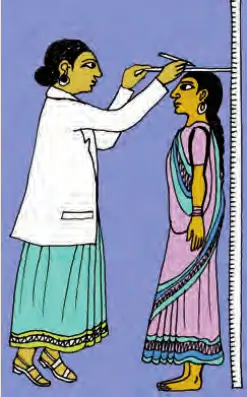
TEXTBOOK EXERCISE
Question.1. Development of a country can generally be determined by
(A) Its per capita income
(B) Its average literacy level
(C) Health status of its people
(D) All of the above
Answer. (D) All of the Above
Question.2. Which of the following neighbouring countries has better performance in terms of human development than India?
(A) Bangladesh
(B) Sri Lanka
(C) Nepal
(D) Pakistan
Answer. (B) Sri Lanka
Question.3. Assume there are four families in a country. The average per capita income of these families is ₹ 5000. If the income of three families is ₹ 4000, ₹ 7000 and ₹ 3000 respectively, what is the income of the fourth family?
(A) ₹ 7500
(B) ₹ 3000
(C) ₹ 2000
(D) ₹ 6000
Answer. (D) ₹ 6000
Question.4. What is the main criterion used by the World Bank in classifying different countries? What are the limitations of this criterion, if any?
Answer. The World Bank considers the country’s income as a major criterion for classifying the different classes of any country. The countries of the world which have high income are considered developed, while countries with low income are considered less developed. It is believed that more income means that all the things required by the human being can be made available in abundance.
Whatever things people like and want to have, they will be able to get all those things through more income. That’s why higher income is accepted as the main criterion for classification of different classes.
This criterion has been used to classify countries in the ‘World Development Report, 2012’ of the world bank. Countries with per capita income of $13,205 per year or more in 2022 are rich countries and countries with per capita income of $1,085 per year or less are called low income countries. India comes in the category of middle income country, as its per capita income was only $2,277 per year in 2021.
Limitations of the Criteria: The national income of a country cannot be considered a good criterion for the classification of different countries, because the population of different countries is different. By comparing total income, we cannot find out what the average person can earn. Due to this, we do not even get to know the conditions of the people of different countries. Therefore, national income is not a good measure of classification.
Question.5. In what respects is the criterion used by the UNDP for measuring development different from the one used by the World Bank?
Answer. The World Bank’s criteria for measuring development is based on ‘income’ only. There are several limitations of this parameter. Apart from income, there are many other parameters which are necessary to measure development, because human beings do not think only about sufficient income, but they also think about other goals like their security, getting respect and equal treatment from others, freedom etc. also contemplates. UNDP In the Human Development Report published by the Human Development Report, the following criteria have been adopted for development, which are as follows:
- Betterment of health of the people : The main parameter of human development is health or longevity. The higher the life expectancy of the people of different countries, the more developed the country will be considered from the point of view of human development.
- Higher Educational level : Another important parameter of human development is the educational level. The higher the literacy rate in a country, the more developed it is considered and if the rate is lower, then that country is called underdeveloped.
- Higher per capita income : The third step of human development is per capita income. The parameter is per capita income. In a country where the per capita income is high, the standard of living of the people in that country is also good and a good standard of living is the hallmark of development.
In countries where the per capita income of the people is low, the standard of living of the people will also not be good. Such a country cannot be considered as a developed country.
Question.6. Why do we use averages? Are there any limitations to their use? Illustrate with your own examples related to development.
Answer. Total income is not a suitable measure for comparison between two countries as the population of different countries varies, hence the average is used. The limitation of its use is that it does not show us the exact distribution of income among people.
Average is used to estimate any subject or area at different levels. Like all the people in a country get different income, but to know the development level of the country, per capita income is derived, which is derived through the average.
This gives us an idea of the level of development of a country. But there are many problems in using the average. Nothing can be accurately estimated from the average. In this, inequalities are hidden. For example, three out of four families living in a country earn ₹ 400 each and one family is earning ₹ 47,000, while in another country all families earn between ₹ 9,000 and ₹ 8,000. Both the countries have the same average income but in one country the economic inequality is very high, while in the other country all the citizens are at the same level economically. Thus this average is useful for comparison but it hides disparities. This does not show how this income is distributed among people.
Question.7. Kerala, with lower per capita income has a better human development ranking than Haryana. Hence, per capita income is not a useful criterion at all and should not be used to compare states. Do you agree? Discuss.
Answer. If personal aspirations and goals are seen then people do not only think about better income but they also think about their security, getting respect and equal treatment from others, freedom etc. Similarly, when we think about the development of a country, we look at other characteristics other than average income.
Per capita income of Haryana is higher than that of Kerala. Thus, if income is considered as the measure of development, then Haryana will be considered the more and Kerala the least developed state. But if we also consider other criteria, we find that the infant mortality rate in Kerala is much lower than that of Haryana, while Haryana has a higher per capita income. Similarly, Kerala has the higher literacy rate and Haryana has the lower. Thus, per capita income alone cannot be considered as the measure of development. Looking at other parameters, such as literacy, health etc. the condition of Kerala is better than Haryana.
Question.8. Find out the present sources of energy that are used by the people in India. What could be the other possibilities fifty years from now?
Answer. The details of the current sources of energy being used by the people of North India are as follows:
- Use of natural gas : Natural gas is also being used a lot as a means of power. Gas is transported to distant places with the help of pipes. Due to this work is done in many industrial units.
- Use of hydropower : This is the cheapest renewable resource of energy. It is widely used in homes, offices and industrial units.
- Uses of Coal : Coal is used as a fuel and as a raw material in industries. Steam engines in which coal is used are used in railways and industries.
- Use of mineral oil : Mineral oil is used in road transport, ships, airplanes etc. Diesel, kerosene, petrol etc. are obtained by refining oil.
- Use of other sources of energy : There are some sources of energy which have been used since some time ago. All these sources are renewable. Such as wind energy, solar energy, biogas, geothermal energy etc.
Most of the traditional sources of energy have been in use for a long time. All these sources are non-renewable, that is, they get exhausted once used. It is not possible to replenish them. In the coming 50 years, if these resources continue to be used like this, they will be exhausted. If we have to save these resources, then we have to find new and renewable sources of energy and use them more and more.
Question.9. Why is the issue of sustainability important for development?
Answer. Sustainability refers to sustainable development or a development that is not limited to the present generation but also to the generations to come. Scientists say that the way we are using the resources, it seems that the resources will get exhausted soon and will not be left for future generations. If we have to make development sustainable, that is, to continue, we have to use resources in such a way that the process of development continues and resources can be saved for future generations. The concept of sustainability is important for development because of the following reasons:
- It takes into account the future requirements.
- It encourages judicious use of natural resources.
- It gives importance to quality life.
Question.10. “The Earth has enough resources to meet the needs of all but not enough to satisfy the greed of even one person”. How is this statement relevant to the discussion of development? Discuss.
Answer. Many types of resources are found on earth. Man uses these resources to fulfill his various needs, then these resources become resources. These resources are not unlimited which will continue till eternity. Therefore, if man uses these resources wisely, he can fulfill all his needs. If the resources are not misused, then the process of development can be continued continuously by using them.
But if these resources are used for personal gain, then it may not be able to fulfill the benefit of a person. If these resources are used indiscriminately then one day they will get exhausted. Non-renewable resources which are limited and once used they get over, they should be used thoughtfully. While using them, we have to keep in mind the needs of the coming generations. In this way, we learn from the above statement that natural resources should be used only to fulfill the needs and not for the fulfillment of personal interest. Due to this, these resources will be exhausted soon and the process of development will stop.
Question.11. List a few examples of environmental degradation that you may have observed around you.
Answer. Following are some examples of environmental degradation:
- Threat to ground water : Ground water in India is in great danger because it is being overused in many parts of our country.
- Destruction of forests : Forests are being cut indiscriminately in different parts and states of India.
- Extinction of wild animals : People are killing wild animals by poaching them.
- Rapid use of coal, oil and petroleum products : Coal, oil and petroleum products are being used at a rapid pace in India for various purposes.
- Excessive construction of dams : Dams are being built without proper planning for the rehabilitation of the people of the displaced area.
- Excessive use of chemicals and pesticides : To increase production, farmers are using chemicals and pesticides on a large scale.
Soil pollution, air pollution and destruction of forests and wildlife are visible through the above works.
Question.12. For each of the items given in Table 1.6, find out which country is at the top and which is at the bottom.
Answer. The Table 1.6 is as follows: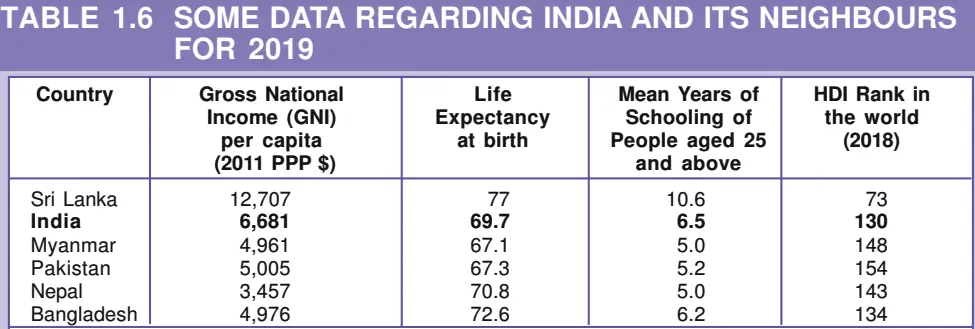
Question.13. The following table shows the proportion of adults (aged 15-49 years) whose BMI is below normal (BMI <18.5 kg/m² ) in India. It is based on a survey of various states for the year 2015-16. Look at the table and answer the following questions.
(i) Compare the nutritional level of people in Kerala and Madhya Pradesh.
Answer. The above figures represent the nutritional status of the people of Kerala and Madhya Pradesh. According to this, 8.5 percent of men and 10 percent of women in Kerala are undernourished, while 28 percent of men and 28 percent of women in Madhya Pradesh are undernourished. This means that more people in Madhya Pradesh are undernourished.
(ii) Can you guess why around one-fifth of people in the country are undernourished even though it is argued that there is enough food in the country? Describe in your own words.
Answer. Despite having sufficient food grains in the country, 20 percent of the people of the country are undernourished because still about 20 percent of the people are below the poverty line. These people are not even able to earn enough to get food for two times. That’s why despite the availability of food grains in the country, they are not able to buy it and they remain ‘undernourished’.



